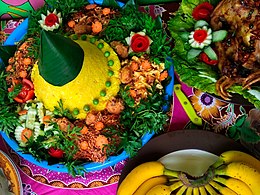Batak cuisine

 |
| This article is part of the series on |
| Indonesian cuisine Masakan Indonesia |
|---|
|
|
Batak cuisine is the cuisine and cooking traditions of
Batak people are majority Christian — unlike neighboring Muslim-majority ethnic groups such as Aceh and Minang — Christian Batak people are not restricted to Islamic halal dietary law.[2] Many of the Batak's popular meals are made of pork as well as dishes made from unusual ingredients, such as dog meat or blood, however there are also halal batak dishes, mostly chicken, beef, lamb, mutton, and freshwater fishes.
Batak culinary centers are located in towns of Batak highlands, such as the town of Kabanjahe and Berastagi in Tanah Karo area. While some towns around the Lake Toba offers freshwater fish dishes such as carp arsik. The Northern Sumatra capital of Medan is also a Batak cuisine hotspot where numerous of Lapo (Batak eating establishments) can be found, yet the city is also a culinary center of halal Malay Deli, as well as Indian Cuisine and Chinese Indonesian cuisines. Outside its traditional lands in North Sumatra, Batak cuisine can also be found in Lapo in Jakarta, as well as most of the Indonesian major cities. Batak food is also widely present in Penang, Malaysia due to wide Batak migrant labour population found there.
History
Cooking traditions in many parts of
Spices and flavourings
Regional differences between Batak and Acehnese culinary influences, among others, are characterized by the choice of spices;
The most widely used spice in Batak cuisine is andaliman and batak onion (
.Meat


For many centuries
However, there is also
food and forbid consumption of pork, dog meat, and blood.Popular Batak pork dish are saksang, fried cutlets sauteed pork in thick spicy blood sauces and Babi Panggang Karo (karo roast pork) — often shortened to BPK — which is locals' favourite and has become nationally famous through Lapo Batak restaurants nationwide. BPK consists of roasted pork slices with three accompaniments: a bowl of broth made from the essence of boiled pig's bones, a platter of porcine blood cooked with pepper and chili, and a saucer of extra-hot chili sauce.[2]
Another common meat consumed in the Batak cuisine is
Fish

Since the Batak tribes live in the interior of North Sumatra, freshwater fish that live in rivers or
Exotic dishes
Batak dishes sometimes use unusual meats such as dog meat (B1 or "biang" ) cooked as saksang or roasted as panggang.
One unusual notorious dish is Pagit-pagit that has distinctly pungent aroma. The ingredients include a brew of cassava leaves, santan (coconut milk), rimbang (a bitter but non-toxic variety of the nightshade family), flowers of some locally-available plants and some arsik sauce, pork or beef meat, mixed with additional unusual substance — juice from a cow's cud, food that has been digested and regurgitated.
Another exotic and rare ingredients is
Beverages
For the Batak community,
Dishes

- Saksang
- Arsik
- Panggang
- Ayam Tasak Telu
- Manuk Napinadar
- Tanggotanggo
- Dengke Mas na Niura
- Na Tinombur
- Mie gomak
- Na Nidugu
- Dali ni Horbo
- Sambal Tuktuk
- Pagit-pagit
- Daun ubi tumbuk
Snacks
- Itak Gurgur
- Kue Pohulpohul
- Kue Ombusombus
- Kue Lampet
- Kue Benti
- Tipatipa
- Kacang Sihobuk
- Sasagun
- Bika Ambon
See also
- Indonesian cuisine
- Minangkabau cuisine
- Palembang cuisine
- Javanese cuisine
References
- ^ a b ROW/WSI (20 April 2013). "Andaliman, Batas Bumbu Batak dan Aceh". kompas.com (in Indonesian). Kompas.com. Retrieved November 10, 2013.
- ^ a b Roslin, Tash (June 30, 2009). "Batak Karo, Extremes In Cuisine". www.thejakartaglobe.com. The Jakarta Globe. Archived from the original on November 10, 2013. Retrieved November 10, 2013.
- ^ Wan Ulfa Nur Zuhra (21 January 2013). "Enjoying 'tuak' in Batak country". The Jakarta Post. Retrieved 5 November 2015.
External links
 Media related to Batak cuisine at Wikimedia Commons
Media related to Batak cuisine at Wikimedia Commons
